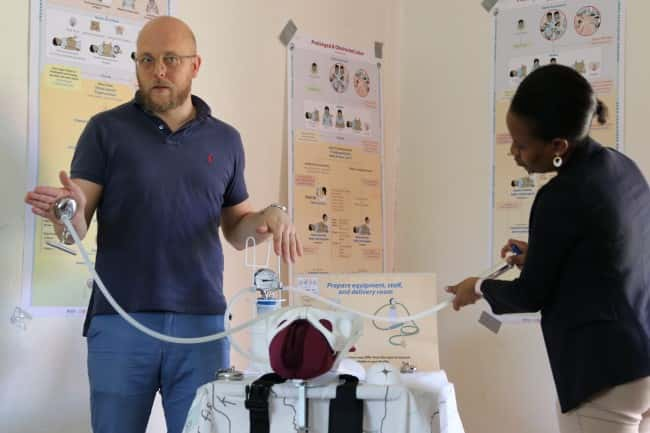Why Vacuum-Assisted Births Can Help Save Lives


According to the World Health Organization, caesarean sections account for more than 1 in 5 of all childbirths. This number is on the rise, with a prediction of nearly a third of all births by caesarean section by 2030.
Access to safe caesarean birth could avert more than 100,000 maternal deaths and reduce neonatal mortality by 30-70%. However, c-sections also increase the risk of a mother or baby dying. While some c-sections are necessary, many can be avoided by effective use of Vacuum Assisted Birth (VAB).
We asked OBGYN Dr. Jørgen Linde from the Stavanger University Hospital, Norway about the use of simulation-based training of VAB to ensure healthcare personnel are prepared to save lives.

What causes prolonged or obstructed labor?
Prolonged labor is when labor lasts for around 20 hours or more for a first birth or more than 14 hours for a subsequent birth. At that point, time is running out and it can become dangerous for both mother and baby.
Obstructed labor is when there’s an obvious obstruction, or if the passage is too narrow, or if the baby is in an impossible position to proceed and gets struck.
When would a mother need to have a vacuum-assisted birth?
Vacuum Assisted Birth, or VAB, is considered an obstetric opportunity during the 2nd stage of labor. When the cervix is fully opened and the baby is descended below the ischial spine, there is a window of time when VAB can be used. If a mother has been actively pushing more than 2 hours or more than 1 hour with a multiple birth or there are signs of fetal distress, VAB can be an effective procedure to speed up delivery. But this is a window of opportunity that is not always possible, for example if there is full opening, but not proper descent and the baby has not passed most narrow part of pelvis. In this case, vacuum cannot be used, so it’s important to understand when and when not to attempt a vacuum assisted delivery.
Why have a vacuum-assisted birth rather than a caesarean section?
If there is a choice, VAB is preferred to c-section. C-sections are resource intense, requiring time preparation, a one-hour surgery requiring three health personnel. But most importantly, I would argue that c-sections are one of the highest risk surgeries to have. This is because there are 3 liters per minute of blood supply making the risk of bleeding or other adverse outcomes high. If the labor is prolonged, risk of bleeding is even more likely.
VAB is a very effective alternative to c-section. When it’s possible to perform a VAB, the procedure is quicker – it takes only 20 minutes. That is not only effective for healthcare personnel, but it also means that a baby who is at risk for asphyxiation can be delivered more quickly.
What are the risks associated with vacuum-assisted births (VAB)?
A failed VAB is when the baby cannot be extracted. Then an emergency c-section is necessary. When performing a VAB, there is a risk that the baby could be pulled in the wrong direction if the personnel are not properly trained. This can result in a tear in the perineum. While this is not a desired outcome, of course, it is not a life-threatening risk. In many cases it is reparable.
How common is VAB? Is there a difference between frequency of use of VAB in high- and low-income countries?
As I said, the window of opportunity for VAB is only during the 2nd stage of labor, so that automatically limits the use in general. But geography does play a role. In high income countries, the use of VAB is more prevalent. Where I work at the hospital in Stavanger, Norway there is about 9-12 % vacuum assisted births in the past years. In some places in Europe, it’s as much as 16%.
I also work at a hospital in Tanzania, where until recently there were almost no vacuum assisted births - literally 0.01%. Why? One reason is that during the HIV pandemic there was a fear of transferring the disease. This is less the case today. With new medications there is a low transfer of the disease. The risk to the unborn baby is a higher priority, to avoid birth asphyxia.
What needs to happen for the use of VAB to become more widely performed?
First, there needs to be more awareness about VAB as an effective alternative to c-section – it’s effective in terms of both cost effectiveness and lifesaving. Another important barrier to VAB is the infrequent use of the partogram in many countries. The partogram is a tool to monitor the active phase of the first stage of labor which is necessary to be able to accurately identify the 2nd stage of labor. To perform a VAB, remember, there is a window in the second stage.
Also, there needs to be more training. Right now, VAB is included in the standard Basic emergency obstetric and newborn care (BEmONC) and Comprehensive Emergency Obstetrics and Newborn Care (CEmONC) trainings. But one training not enough. The VAB procedure is a skill that requires practice and frequent refresher training to maintain competence. Implementing a simulation-based low dose high frequency training methodology can improve the confidence of health personnel.
What improvements are you seeing in Tanzania?
While traditionally a procedure reserved for doctors, our research project in Tanzania aimed to train both midwives and doctors to work as a team to perform VAB. After these team trainings, 1/3 of VAB are done by midwives with doctors. In many places, doctors are a scarce resource. It’s the midwives who are with the laboring women, so it’s important to cooperate. The key to success is cooperation. Our research is not in the stage where we’re assessing the implementation. We’re seeing very few adverse outcomes and the preliminary results are promising.
How would you define success?
I would like to see a change in culture for the use of VAB. Using VAB reduces the likelihood of c-sections for subsequent pregnancies. If a mother can deliver vaginally the first time, there is a 95 % chance she can deliver vaginally the next time. With a c-section, there is a higher likelihood of c-sections in subsequent pregnancies. In Africa, the mean number of children is 4.8. So avoiding a first c-section is very beneficial.
Over time, I hope we can decrease the number of unnecessary c sections increase safe vacuum assisted births that would be success for everyone – health personnel, mothers, and babies.
What is the most inspiring or motivating story related to your experience performing VAB?
A midwife who had been trained with us at Haydom Hospital was visiting a neighbor hospital to transfer a woman who was experiencing a prolonged labor. The woman had been in 2nd stage for too long, so the midwife suggested vacuum assisted birth. But no one there knew how to do it. So, she did it. If the mother had to make the one-hour transfer between hospitals, it could have been deadly. Instead, a healthy baby was delivered.